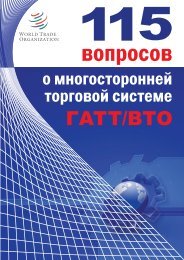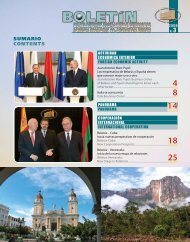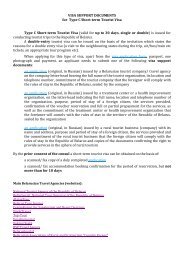Providing publicservices that contributeto a healthy, educatedlabour force helpsbuild national stability,reducing the likelihoodof political unrest andstrengthening thelegitimacy of governmentsequality—also helps reduce social conflict.The sharpest contractions in growth after1975 occurred in countries with dividedsocieties (as measured by indicators of inequalityand ethnic fragmentation). They alsosuffered from weak institutions for conflictmanagement, with poor quality governmentinstitutions that had less capacity to ensurethe rule of law, democratic rights and socialsafety nets. 93Education, health care, social protections,legal empowerment and social organization allenable poor people to participate in growth.But even these basic policy instruments maynot empower disenfranchised groups. Poorpeople on the fringes of society struggle tovoice their concerns, and governments do notalways evaluate whether services intended toreach everyone actually do. 94 Often, problemsare exacerbated by external shocks, but in manycases policies are implemented where localinstitutional capacity and community involvementare low.• Uganda. In post-conflict Uganda, a seriesof macroeconomic reforms, from theloosening of price control and exchangerates to changes in state-owned enterprisesand the civil service, paved the way for awide-ranging poverty reduction plan in1997. Uganda went on to become one ofthe few Sub-Saharan African countries tohave halved extreme poverty before theMillennium <strong>Development</strong> Goal deadline of2015, from 56.4% in 1992–1993 to 24.5%in 2009–2010. However, increasing incomeinequality has slowed the pace of poverty reduction.95 On balance, the economic successof these efforts show that programmes aremore effective when the national leadershipis committed to reducing poverty, notablyby enhancing the consistency of goals andapproaches across government agencies. 96 Inturn, such progress can have a profound influenceon the legitimacy of leaders and theirgovernments.Promoting inclusionAll countries have, to a greater or lesser extent,multireligious, multicultural, pluralisticsocieties, and different groups generally havedifferent levels of human development. Even inadvanced countries, there is persistent discriminationagainst certain ethnic groups in labourmarkets. 97 Nonmarket discrimination can beequally severe and destabilizing. Moreover,historical discrimination has long-lasting effects.Ensuring nondiscrimination and equaltreatment, including providing special programmesfor disadvantaged groups, is becomingincreasingly critical for political and socialstability.In the South, too, different levels of achievementoften have historical or colonial origins—for instance, in India, between upper and lowercastes, and in Malaysia, among Bumiputras(Malays), Chinese and Indians. Economicprosperity alone cannot end group discriminationthat leads to horizontal inequality.To bridge inequalities and correct historicaldisadvantages, both India and Malaysia haveadopted deliberate policy interventions, suchas affirmative action.Providing basic social servicesStates can underpin long-term economicgrowth by providing public services thatcontribute to a healthy, educated labourforce. Such measures also help build nationalstability, reducing the likelihood of politicalunrest and strengthening the legitimacy ofgovernments.Developing countries sometimes receivepolicy advice urging them to view publicexpenditures on basic services as luxuriesthey cannot afford. Over the long term,however, these investments pay off. Althoughnot all services need be publicly provided,a minimum universal level of basic health,education and social security needs to be establishedto ensure that all citizens have secureaccess to the basic requirements of humandevelopment, whether from public or privateproviders. Compulsory public primary andsecondary education has contributed decisivelyto human development in Europe andin some developing countries, such as CostaRica.Access to high-quality educationGrowth in HDI value is associated with growthin public spending on education. On average,78 | HUMAN DEVELOPMENT REPORT <strong>2013</strong>
countries with higher government expenditureson health and education have experienced highgrowth in human development, although localvariations may remain.• Indonesia. During Indonesia’s economicboom years (from 1973 onwards), the governmentfunded the construction of schoolsfor basic education through developmentprogrammes, and in the following decadepublic expenditure on education more thandoubled.• India. Following the constitutional amendmentto make education a fundamental rightfor every child, India has taken progressivesteps towards ending discrimination in itsschool system (box 3.6).• Ghana. One of the earliest initiatives in independentGhana was the 1951 Accelerated<strong>Development</strong> Plan for Education, whichaimed at a massive expansion of primaryand middle school education. The 1961Education Act removed fees for elementaryeducation so that households had to pay onlya modest amount for textbooks. Enrolmentin public elementary schools doubled overthe next six years. Between 1966 and 1970,the public discourse on education movedfrom access to quality. In the early 1970s,the focus came back to access, this time forsecondary education. The next major roundof reforms took place in 1987. The mostsignificant aspect of the curriculum reformwas to provide children with literacy in threelanguages—two Ghanaian languages andEnglish—as well as modern farming skills,vocational skills and practical mathematicsskills.• Mauritius. The government of Mauritiusdeveloped a national consensus on providinghigh-quality primary, secondary and tertiaryschooling free of charge.• Bangladesh. The Ministry of Primary andMass Education was established in 1992with the goal of universalizing primary educationand eliminating gender and povertygaps in primary education in Bangladesh.Demand-side interventions, such as theFemale Secondary School AssistanceProgram and the Food for Education programme,broadened coverage, particularlyfor girls.• China. In 1986, China’s National People’sCongress passed a law proclaiming thecompulsory provision of nine-year basiceducation regardless of gender, ethnicity orrace. From 1990 to 2000, the average yearsBOX 3.6India’s Supreme Court issues a progressive verdict mandating seats for disadvantaged children in private schoolsMost schools in developing countries are government run, but demand forprivate schools is expanding in response to the failures of public schools:bad infrastructure, overcrowded classrooms, poor access, teacher shortagesand absenteeism. Parents with enough money send their children to privateschools, creating a society in many countries divided between public andprivate school students.India has made education free and compulsory for children ages 6–14.The vast majority of children are enrolled in government schools, especiallyin rural areas. But most children from elite households—the rich, the politicalclass, government employees and the growing middle class—are sentto private schools. In many instances, boys are sent to private schools, andgirls to free government schools.To reduce these trends towards segregation, India passed the Rightof Children to Free and Compulsory Education Act in 2009. It requires privateschools to admit at least 25% of students from socially disadvantagedand low-income households. In turn, private schools are reimbursed foreither their tuition charge or the expenditure per student in governmentschools, whichever is lower. The act was based on the following rationales:schools must be sites for social integration, private schools do not existindependently of the state that provides them land and other amenities,the social obligation of private schools cannot be waived by contendingthat only children whose parents pay their fees have a right to be in theseschools and the requirement to admit at least 25% of students from disadvantagedgroups is fair given that these groups constitute around 25% ofthe population.In a landmark judgement on 12 April 2012, the Supreme Court of Indiaupheld the constitutional validity of the act, making two points in supportof its decision. First, since the act obligates the state to provide free andcompulsory education to all children ages 6–14, the state has the freedomto decide whether it shall fulfil its obligation through its own schools,aided schools or unaided schools. The 2009 act is “child-centric” and not“institution- centric”. Second, the right to education “envisages a reciprocalagreement between the state and the parents, and it places an affirmativeburden on all stakeholders in our civil society.” Private, unaided schools supplementthe primary obligation of the state to provide free and compulsoryeducation to the specified category of students.Source: Government of India 2009; Supreme Court of India 2012.Chapter 3 Drivers of development transformation | 79
- Page 1 and 2:
WNSEHuman DevelopmentReport 2013The
- Page 3 and 4:
Human Development Report 2013The Ri
- Page 5 and 6:
Human Development Report 2013 TeamD
- Page 7 and 8:
Finally, the Report also calls for
- Page 9 and 10:
Heather Simpson, Ben Slay, Mounir T
- Page 11 and 12:
3.6 India’s Supreme Court issues
- Page 13 and 14:
OverviewOne of the most heartening
- Page 15 and 16:
and sustainability are fully incorp
- Page 17 and 18:
Without investment in people, retur
- Page 19 and 20:
opportunity to reap the full benefi
- Page 21 and 22:
Woods institutions, the United Nati
- Page 23 and 24:
IntroductionWhen developed economie
- Page 25 and 26:
leading economies—Brazil, China a
- Page 27 and 28:
comparable access to information, e
- Page 29 and 30:
mobile phones: cellular banking is
- Page 32 and 33:
“The political problem ofmankind
- Page 34 and 35:
BOX 1.1Fairness, macroeconomics and
- Page 36 and 37:
BOX 1.3Amartya Sen, Nobel Laureate
- Page 38 and 39:
FIGURE 1.1Income per capita is risi
- Page 40 and 41: BOX 1.4Subjective indicators of wel
- Page 42 and 43: FIGURE 1.4There is notable variatio
- Page 44 and 45: FIGURE 1.6Most regions show declini
- Page 46 and 47: Progress in humandevelopment achiev
- Page 48 and 49: BOX 1.7Social competencies: human d
- Page 50 and 51: TABLE 1.3Inequality and satisfactio
- Page 52 and 53: Not all countries havethe precondit
- Page 54 and 55: “When the music changes,so does t
- Page 56 and 57: BOX 2.1The South’s integration wi
- Page 58 and 59: FIGURE 2.1As a share of world merch
- Page 60 and 61: BOX 2.2Acquisitions by the South of
- Page 62 and 63: FIGURE 2.3Between 2000 and 2010, In
- Page 64 and 65: FIGURE 2.4Export earnings per capit
- Page 66 and 67: BOX 2.6Final assembly is about more
- Page 68 and 69: Instead of having a centreof indust
- Page 70 and 71: FIGURE 2.6Emerging market economies
- Page 72 and 73: Developing countriestrade more amon
- Page 74 and 75: “We cannot expect thatall nations
- Page 76 and 77: TABLE 3.1Selected developing countr
- Page 78 and 79: A common featureof countries thatha
- Page 80 and 81: More important thangetting prices r
- Page 82 and 83: BOX 3.5Eastern Europe and Central A
- Page 84 and 85: States have to beconscious that the
- Page 86 and 87: As countries develop,they tend to d
- Page 88 and 89: Having weathered theAsian financial
- Page 92 and 93: Advancing health requiresmore than
- Page 94 and 95: Universal public healthand educatio
- Page 96 and 97: • China. The Minimum Livelihood G
- Page 98 and 99: “Each generation will reap whatth
- Page 100 and 101: concerns will make for a complex en
- Page 102 and 103: A greater emphasison education cans
- Page 104 and 105: FIGURE 4.1Under the fast track scen
- Page 106 and 107: Around the worldpeople are calling
- Page 108 and 109: FIGURE 4.4Different environmental s
- Page 110 and 111: FIGURE 4.5Education policies can al
- Page 112 and 113: BOX 4.2China and Ghana: who benefit
- Page 114 and 115: FIGURE 4.8countries thus converge t
- Page 116 and 117: “Let us join hands to try tocreat
- Page 118 and 119: Areas of globalinternational concer
- Page 120 and 121: Addressing climatechange requires t
- Page 122 and 123: International governanceis increasi
- Page 124 and 125: BOX 5.2Jo Leinen, Member of the Eur
- Page 126 and 127: facilitates reserve investments and
- Page 128 and 129: Responsible sovereigntytakes the lo
- Page 130 and 131: FIGURE 5.1Under the accelerated pro
- Page 132 and 133: Good policymakingrequires greater f
- Page 134 and 135: A fair and less unequalworld requir
- Page 137 and 138: NotesOverview1 Atsmon and others 20
- Page 139 and 140: 25 Blinder 2006.26 UNIDO 2009.27 UN
- Page 141 and 142:
which is 61.7 deaths per 1,000 live
- Page 143 and 144:
ReferencesAbdurazakov, A., A. Minsa
- Page 145 and 146:
urban_world_cities_and_the_rise_of_
- Page 147 and 148:
Kamau, P., D. McCormick, and N. Pin
- Page 149 and 150:
Labor Administration. Geneva: Inter
- Page 151 and 152:
Human Development Report 2013The Ri
- Page 153 and 154:
Statistical acknowledgementsThe Rep
- Page 155 and 156:
Key to HDI countries and ranks, 201
- Page 157 and 158:
Human Development Report 2013The Ri
- Page 159 and 160:
Human Development Report 2013The Ri
- Page 161 and 162:
Human Development Report 2013The Ri
- Page 163 and 164:
Human Development Report 2013The Ri
- Page 165 and 166:
Human Development Report 2013The Ri
- Page 167 and 168:
Human Development Report 2013The Ri
- Page 169 and 170:
Human Development Report 2013The Ri
- Page 171 and 172:
Human Development Report 2013The Ri
- Page 173 and 174:
Human Development Report 2013The Ri
- Page 175 and 176:
Human Development Report 2013The Ri
- Page 177 and 178:
Human Development Report 2013The Ri
- Page 179 and 180:
Human Development Report 2013The Ri
- Page 181 and 182:
Human Development Report 2013The Ri
- Page 183 and 184:
Human Development Report 2013The Ri
- Page 185 and 186:
Human Development Report 2013The Ri
- Page 187 and 188:
Human Development Report 2013The Ri
- Page 189 and 190:
Human Development Report 2013The Ri
- Page 191 and 192:
Human Development Report 2013The Ri
- Page 193 and 194:
Human Development Report 2013The Ri
- Page 195 and 196:
Human Development Report 2013The Ri
- Page 197 and 198:
Human Development Report 2013The Ri
- Page 199 and 200:
Human Development Report 2013The Ri
- Page 201 and 202:
Human Development Report 2013The Ri
- Page 203 and 204:
Human Development Report 2013The Ri
- Page 205 and 206:
Human Development Report 2013The Ri
- Page 207 and 208:
Human Development Report 2013The Ri
- Page 209 and 210:
Human Development Report 2013The Ri
- Page 211 and 212:
Statistical referencesADB (Asian De
- Page 213 and 214:
Core features of the model pertinen
- Page 215 and 216:
Countries and HDI ranks in 2012 and
















